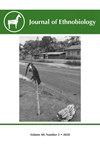Useful Plants from the Wild to Home Gardens: An Analysis of Home Garden Ethnobotany in Contexts of Habitat Conversion and Land Use Change in Jeju, South Korea
IF 1.3
3区 社会学
Q1 ANTHROPOLOGY
引用次数: 1
Abstract
Abstract. Home gardens are often the most agrobiodiverse sites in the anthropogenic environment, a space where crops and other useful plants are often transplanted from other components of the landscape. This study investigates the plant composition of home gardens and their usefulness in 12 small towns and villages—with three of these chosen as the focus for in-depth research—situated in the Jeju province of South Korea. The goal of the research is to explore their roles in local ethnobotany in the context of habitat conversion and land use change. The 131 home gardens surveyed in these villages yielded 164 species- and variety-level plant taxa (52 wild, 109 domesticated, and 3 introduced), of which 95 were useful plant taxa (39 wild, 55 domesticated, and 1 introduced). Use of home garden plants was predominantly for food and medicinal purposes. Home garden plant usefulness was more multi-functional and thus more versatile than practices associated with these plants in non-garden habitats. Plant diversity in home gardens was supported by the presence of nearby forest and grassland areas. Interview data indicate that plant users were motivated to transplant wild plants into their home gardens in order to secure a consistent supply, given decreases in wild plant populations in the last 15–20 years. The loss and overharvesting of forests and other wild plant habitats have caused the decrease in these plant populations. Underlying drivers of the habitat conversion and land use change influencing increased wild plant transplants to home gardens are local livelihood and lifestyle changes, including the earlier expansion of commercial agriculture beginning in the late 1960s and the accelerated growth of tourism since 2000.从野生植物到家庭花园的有用植物——韩国济州栖息地转换和土地利用变化背景下的家庭花园民族植物学分析
摘要家庭花园通常是人类环境中农业生物多样性最强的地方,在这个空间里,作物和其他有用的植物经常从景观的其他组成部分移植过来。这项研究调查了位于韩国济州省的12个小城镇和村庄的家庭花园的植物组成及其实用性,其中三个被选为深入研究的重点。研究的目的是在栖息地转换和土地利用变化的背景下,探索它们在当地民族植物学中的作用。在这些村庄调查的131个家庭花园中,产生了164个物种和品种级植物类群(52个野生,109个驯化,3个引种),其中95个是有用的植物类群(39个野生,55个驯化,1个引种)。家庭花园植物的使用主要用于食品和药用目的。与非花园栖息地中与这些植物相关的实践相比,家庭花园植物的实用性更具多功能性,因此更具多样性。附近森林和草原地区的存在支持了家庭花园中的植物多样性。访谈数据表明,鉴于过去15-20年野生植物数量的减少,植物使用者有动机将野生植物移植到他们的家庭花园中,以确保稳定的供应。森林和其他野生植物栖息地的丧失和过度捕捞导致了这些植物种群的减少。栖息地转换和土地利用变化影响野生植物移植到家庭花园的增加,其根本驱动因素是当地生计和生活方式的变化,包括从20世纪60年代末开始的商业农业的早期扩张,以及自2000年以来旅游业的加速增长。
本文章由计算机程序翻译,如有差异,请以英文原文为准。
求助全文
约1分钟内获得全文
求助全文
来源期刊

Journal of Ethnobiology
Social Sciences-Anthropology
CiteScore
4.80
自引率
3.40%
发文量
21
审稿时长
>12 weeks
期刊介绍:
JoE’s readership is as wide and diverse as ethnobiology itself, with readers spanning from both the natural and social sciences. Not surprisingly, a glance at the papers published in the Journal reveals the depth and breadth of topics, extending from studies in archaeology and the origins of agriculture, to folk classification systems, to food composition, plants, birds, mammals, fungi and everything in between.
Research areas published in JoE include but are not limited to neo- and paleo-ethnobiology, zooarchaeology, ethnobotany, ethnozoology, ethnopharmacology, ethnoecology, linguistic ethnobiology, human paleoecology, and many other related fields of study within anthropology and biology, such as taxonomy, conservation biology, ethnography, political ecology, and cognitive and cultural anthropology.
JoE does not limit itself to a single perspective, approach or discipline, but seeks to represent the full spectrum and wide diversity of the field of ethnobiology, including cognitive, symbolic, linguistic, ecological, and economic aspects of human interactions with our living world. Articles that significantly advance ethnobiological theory and/or methodology are particularly welcome, as well as studies bridging across disciplines and knowledge systems. JoE does not publish uncontextualized data such as species lists; appropriate submissions must elaborate on the ethnobiological context of findings.
 求助内容:
求助内容: 应助结果提醒方式:
应助结果提醒方式:


